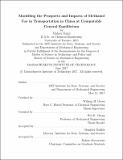Modelling the prospects and impacts of methanol use in transportation in China at computable general equilibrium
Author(s)
Nami, Mahsa
DownloadFull printable version (5.471Mb)
Other Contributors
Massachusetts Institute of Technology. Department of Electrical Engineering and Computer Science.
Advisor
William H. Green.
Terms of use
Metadata
Show full item recordAbstract
The use of methanol as a transportation fuel is not a new phenomenon. However, factors such as price fluctuations, resistance to widespread introduction by special interest groups, and governmental policies have stood in the way of the widespread use of methanol in covering transportation demand. In this thesis, a computable general equilibrium energy-economy model of the world, the Economic Projection and Policy Analysis (EPPA) model, is used to evaluate the potential for methanol vehicle penetration in the private passenger vehicle market in China depending on the cost competitiveness of the technology combination compared to electric and conventional vehicles, the relative prices of methanol and gasoline, and the application of various policies. The use of methanol in light duty passenger vehicles has risen heavily in China due to the abundance of coal in the country and the ability to use it as the feedstock for methanol production in China, thereby reducing China's reliance on foreign oil imports. Additionally, the lower price of methanol fuel compared to gasoline has led it to be an attractive fuel choice from the customer perspective due its favorable economics, with a growing number of individuals converting their conventional vehicles to be able to run on methanol. Since China is not a country abundant with natural gas, the two leading options for obtaining methanol are obtaining it through the use of coal as the feedstock locally or importing it from other countries which are producing methanol using natural gas. Methanol fuel production pathways and the vehicle technology are introduced in EPPA as a substitute for conventional Internal Combustion Engine (ICE) vehicles. Engineering cost estimates as well as existing transportation expenditure trends in China are used for obtaining the input shares and elasticities of substitution as inputs to the model. Simulations are then run until 2050 to understand the rate at which the methanol vehicle technology penetrates the market when competing with electric vehicles and conventional vehicles in the base case scenario. Accordingly, changes in greenhouse gas emissions and particulate emissions are calculated. On the policy side, various sets of policies are tested: instituting a gasoline tax, banning methanol imports for use in passenger private vehicles, applying various combinations of vehicle subsidies for methanol and electric vehicles, and instituting a carbon cap at a national level. Various conclusions emerge from this thesis. First, the penetration of methanol and electric vehicles are slow, achieving market shares of 4% and 1%, respectively. Despite the lower methanol cost compared to gasoline, the penetration of the technology is slowed down by the higher cost of methanol vehicles compared to conventional vehicles as well as the delays associated with introducing new fuels, new vehicles, and new refueling infrastructure, none of which are completely compatible with the incumbent technology. This shift also results in an increase in greenhouse gas emissions compared to the business as usual scenario but a decrease in emissions of nitrogen oxides, carbon monoxide, and hydrocarbons. Instituting a gasoline tax has a greater impact than existing Chinese vehicle subsidy policies on methanol and electric vehicle penetration. However, the gasoline tax still results in modest methanol and electric vehicle penetration, achieving a market share of 6% each by 2050. Setting a carbon cap under an accelerated effort scenario impacts the vehicle trends most dramatically, completely driving down the use of methanol vehicles and allowing electric vehicles to achieve an 11.47% market share. Finally, these results are used to present various policy recommendations depending on China's existing provincial policy structures, its national objectives, and future goals.
Description
Thesis: S.M. in Technology and Policy, Massachusetts Institute of Technology, School of Engineering, Institute for Data, Systems, and Society, Technology and Policy Program, 2017. Thesis: S.M., Massachusetts Institute of Technology, Department of Electrical Engineering and Computer Science, 2017. Cataloged from PDF version of thesis. Includes bibliographical references (pages 128-134).
Date issued
2017Department
Massachusetts Institute of Technology. Department of Electrical Engineering and Computer Science; Massachusetts Institute of Technology. Engineering Systems Division; Massachusetts Institute of Technology. Institute for Data, Systems, and Society; Technology and Policy ProgramPublisher
Massachusetts Institute of Technology
Keywords
Institute for Data, Systems, and Society., Engineering Systems Division., Technology and Policy Program., Electrical Engineering and Computer Science.